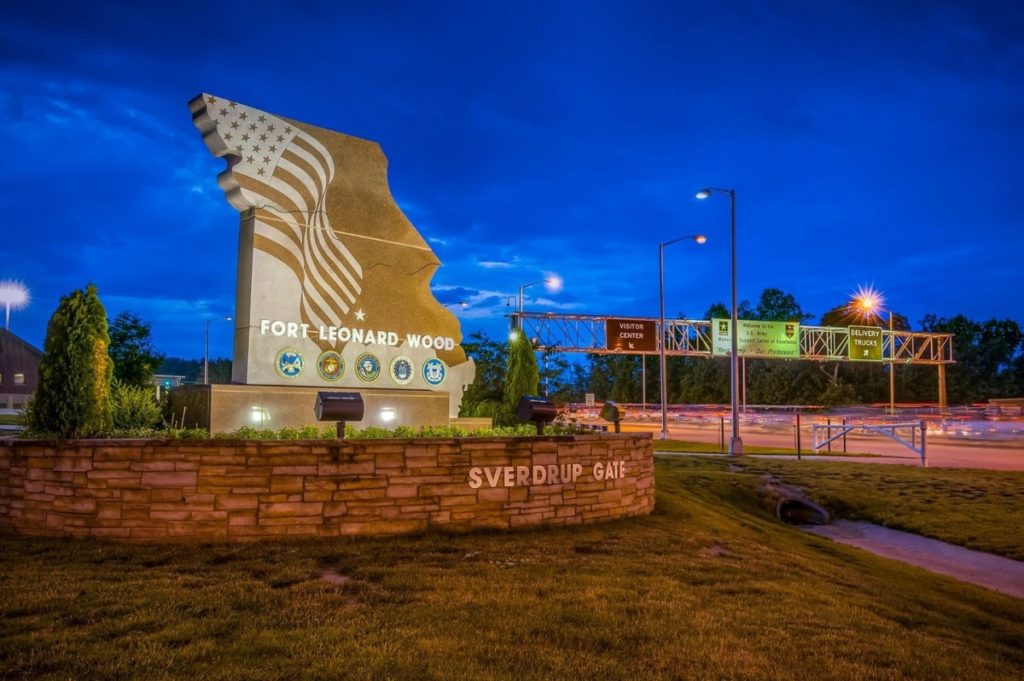Brian Hill
FORT LEONARD WOOD, Mo. (Nov. 9, 2020) — “There will be a hallway here and a wall over there with a door,” said Chief Warrant Officer 3 Matthew Chrisman, U.S. Army Chemical, Biological, Radiological, and Nuclear School deputy chief of the Hazardous Materials Dismounted Reconnaissance Department and project lead on a new training facility being built here that’s being referred to as the Large-Scale Production Facility.
“It’ll be apparent that everyone will need to be in personal protective equipment beyond here,” he continued, pointing out another area of the space still needing construction. “Through the windows that will be installed over here, the Soldiers will see complex laboratory equipment — they’ll be able to tell something’s going on; something’s being produced.”
Chrisman said one of his goals since arriving at Fort Leonard Wood in July has been to get the LSPF ready because of the excellent training opportunities it affords in addition to what’s already available at the Chemical Defense Training Facility.
“The LSPF will complement the CDTF by allowing multiple teams to execute different scenarios simultaneously without the live agents used at the CDTF,” he said. “Teams will also be able to spend more time on target. Training units can enjoy the freedom of being in close proximity to the processes without PPE and conduct lessons to gain a better understanding.”
Chrisman said the LSPF — composed of three buildings — is intended to resemble what an industrialized nation might have on hand to produce chemical or biological warfare agents. The need for training facilities like this comes out of the Army’s recent strategic shift back to what’s been called “peer and near-peer, large-scale combat operations.”
“With the Army’s focus on large-scale operations, the intent is to have something more than clandestine … something that says ‘state sponsored,’” he said. “I want units, when they come here, to think ‘something’s being made here.’ That should be evident just from walking up on the building.”
Chrisman added that professional scientific equipment was brought in to make the site as realistic as possible without actually producing any chemicals.
“This site enables CBRN Soldiers to see what a (weapons of mass destruction) site looks like — true to size and complexity — while becoming familiar with the planning considerations associated with it,” he said. “Future CBRN leaders must become intellectually and experientially equipped to meet these challenges.”
Jessica Arteaga is a USACBRNS Biological Warfare Defense instructor who toured the LSPF site Oct. 28. She said getting students out of the traditional classroom setting can be incredibly useful.
“The educational value of having these facilities will allow students to retain the information much easier in comparison to (teaching from slides),” she said.
The LSPF is slated to be ready in late 2021, and according to Staff Sgt. Brian Reigle, a USACBRNS Technical Escort Course instructor and the action officer on the LSPF project, its completion will give CBRN schools the opportunity to allow students and customers to train in a “functioning, realistic and challenging setting.”
“I’d love to see this project evolve into an available site for full mission profile objectives,” he said. “That would involve multiple (military occupational specialties) all training at the same location — engineers and transportation could be responsible for route clearance and convoy operations; military police could cordon off the area and clear buildings prior to CBRN teams responding to the (chemical) production sites.”

-30-
About Fort Leonard Wood
Fort Leonard Wood is a thriving and prosperous installation that has evolved from a small basic training post more than 75 years ago to a premier Army Center of Excellence that trains more than 80,000 military and civilians each year.
Fort Leonard Wood is home to the U.S Army Maneuver Support Center of Excellence and three U.S. Army schools: the U.S. Army Engineer School; U.S. Army Chemical, Biological, Radiological and Nuclear School; and the U.S. Army Military Police School. In addition to training engineer, CBRN and military police specialties for the Army, Fort Leonard Wood also provides gender-integrated in-processing and Basic Combat Training for new Soldiers.
Fort Leonard Wood also hosts and trains with the largest Marine Corps Detachment and Air Force Squadron on any Army installation as well as a large Navy construction detachment.
More information about Fort Leonard Wood is at: https://home.army.mil/wood/index.php/about/mission


